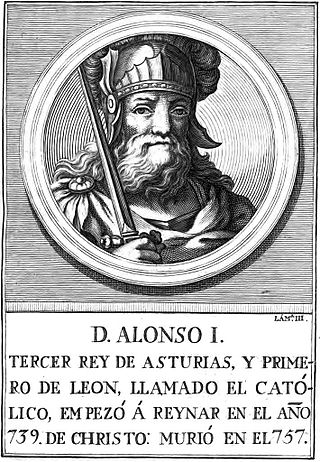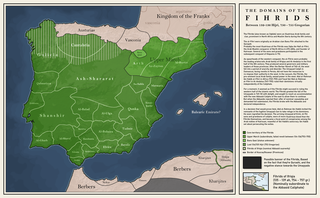
Year 740 (DCCXL) was a leap year starting on Friday of the Julian calendar, the 740th year of the Common Era (CE) and Anno Domini (AD) designations, the 740th year of the 1st millennium, the 40th year of the 8th century, and the 1st year of the 740s decade. The denomination 740 for this year has been used since the early medieval period, when the Anno Domini calendar era became the prevalent method in Europe for naming years.

The Umayyad Caliphate was the second caliphate established after the death of the Islamic prophet Muhammad. The caliphate was ruled by the Umayyad dynasty. Uthman ibn Affan, the third of the Rashidun caliphs, was also a member of the clan. The family established dynastic, hereditary rule with Muawiya ibn Abi Sufyan, long-time governor of Greater Syria, who became caliph after the end of the First Fitna in 661. After Mu'awiya's death in 680, conflicts over the succession resulted in the Second Fitna, and power eventually fell to Marwan I, from another branch of the clan. Syria remained the Umayyads' main power base thereafter, with Damascus as their capital.

Abd al-Malik ibn Marwan ibn al-Hakam was the fifth Umayyad caliph, ruling from April 685 until his death in October 705. A member of the first generation of born Muslims, his early life in Medina was occupied with pious pursuits. He held administrative and military posts under Caliph Mu'awiya I, founder of the Umayyad Caliphate, and his own father, Caliph Marwan I. By the time of Abd al-Malik's accession, Umayyad authority had collapsed across the Caliphate as a result of the Second Muslim Civil War and had been reconstituted in Syria and Egypt during his father's reign.

Hisham ibn Abd al-Malik was the tenth Umayyad caliph, ruling from 724 until his death in 743.
Kulthum ibn Iyad al-Qushayri was an Umayyad governor of Ifriqiya for a few months, from February to his death in October 741.
ʿAbd al-Raḥmān ibn Ḥabīb al-Fihrī was an Arab noble of the Fihrid family, and ruler of Ifriqiya from 745 through 755 AD.
The Berber Revolt of 740–743 AD took place during the reign of the Umayyad Caliph Hisham ibn Abd al-Malik and marked the first successful secession from the Arab caliphate. Fired up by Kharijite puritan preachers, the Berber revolt against their Umayyad Arab rulers began in Tangiers in 740, and was led initially by Maysara al-Matghari. The revolt soon spread through the rest of the Maghreb and across the straits to al-Andalus.
The Battle of the Nobles was an important confrontation in the Berber Revolt in c. 740 AD. It resulted in a major Berber victory over the Arabs near Tangier Morocco. During the battle, numerous Arab aristocrats were slaughtered, which led to the conflict being called the "Battle of the Nobles". Zenata Berber chieftain Khalid ibn Hamid al-Zanati led the revolting Berber soldiers.
Habib ibn Abi Ubaida al-Fihri was an Arab military commander of the illustrious Fihrid family who played an important role in the early history of Ifriqiya (Tunisia) and al-Andalus (Spain).

The Fihrids, also known as Banu Fihr, were an Arab family and clan, prominent in North Africa and Al-Andalus in the 8th century.
The Battle of Bagdoura was a decisive confrontation in the Berber Revolt in late 741 CE. It was a follow-up to the Battle of the Nobles the previous year, and resulted in a major Berber victory over the Arabs by the Sebou River. The battle would permanently break the hold of the Umayyad Caliphate over the far western Maghreb, and the resulting retreat of elite Syrian forces into Spain would have implications for the stability of al-Andalus.
Ubayd Allah ibn al-Habhab al-Saluli was an important Umayyad official in Egypt from 724 to 734, and subsequently Umayyad governor of Kairouan, Ifriqiya from 734 to 741. It was under his rule that the Great Berber Revolt broke out in the Maghreb and al-Andalus.
Handhala ibn Safwan al-Kalbi was an Umayyad governor of Egypt from 721 to 724 and again 737 to 742, and subsequently governor of Ifriqiya from 742 to 745.
Balj ibn Bishr al-Qushayri was an Umayyad military commander in the Maghreb and al-Andalus (Iberia), and briefly became the ruler of al-Andalus in 742 until his death in August of the same year. Balj was a member of the Banu Qushayr, a branch of the Nejdi Hawazin tribe, and was the nephew of Kulthum ibn Iyad al-Qasi, who had been appointed governor of Ifriqiya by the Umayyad caliph Hisham. In 741 Balj was cavalry lieutenant under his uncle's command on a military campaign against a Berber Revolt in North Africa. Kulthum headed an army of 30,000 Arab troops from regiments (junds) from Damascus, Jordan, Qinnasrin, Emesa (Hims), Palestine and Egypt.
Tha'laba ibn Salama al-Amili was an Arab military commander in Jordan, North Africa and the Iberian Peninsula, and briefly ruler of al-Andalus from August 742 to May 743. He died in 750.
Maysar al-Matghari was a Berber rebel leader and original architect of the Great Berber Revolt that erupted in 739-743 against the Umayyad Muslim empire. However, he was deposed by the rebels, replaced with another Berber leader, and died or possibly was executed by them in 740. The Berber Revolt succeeded 3 years after his death in defeating the Umayyad armies.
Khalid ibn Abi Habib al-Fihri was an Arab military commander in North Africa during the Berber Revolt, who led the Arab army that was defeated at the Battle of the Nobles in late 740. The chronicles are oddly ambiguous on the biographical details of Khalid ibn Abi Habib. It is acknowledged that he was a member of the illustrious Fihrid family, descendants of the great Arab conqueror Oqba ibn Nafi al-Fihri. The patronymic structure suggests Khalid is the son of the father of Habib, which would imply that it is likely Khalid was the brother of Habib ibn Abi Obeida al-Fihri, the principal military commander of Ifriqiya. But this is not confirmed.
Sulaymān ibn Hishām ibn ʿAbd al-Malik was an Arab general, the son of the Umayyad Caliph Hisham ibn Abd al-Malik. He is known for his participation in the expeditions against the Byzantine Empire as well as his prominent role in the civil wars that occurred during the last years of the Umayyad Caliphate. Defeated by Marwan II, he fled to India, where he died.
Abd al-Rahman ibn Muhammad ibn al-Ash'ath, commonly known as Ibn al-Ash'ath after his grandfather, was a prominent Arab nobleman and military commander during the Umayyad Caliphate, most notable for leading a failed rebellion against the Umayyad viceroy of the east, al-Hajjaj ibn Yusuf, in 700–703.
Al-Asbagh ibn Dhu'ala al-Kalbi was an Umayyad commander and a warlord of the Banu Kalb tribe in Palmyra who played a prominent role in the Third Muslim Civil War (744–750) and afterward was a leader of the revolt of the Umayyad prince Abu Muhammad al-Sufyani against the Abbasids in 750–751.




